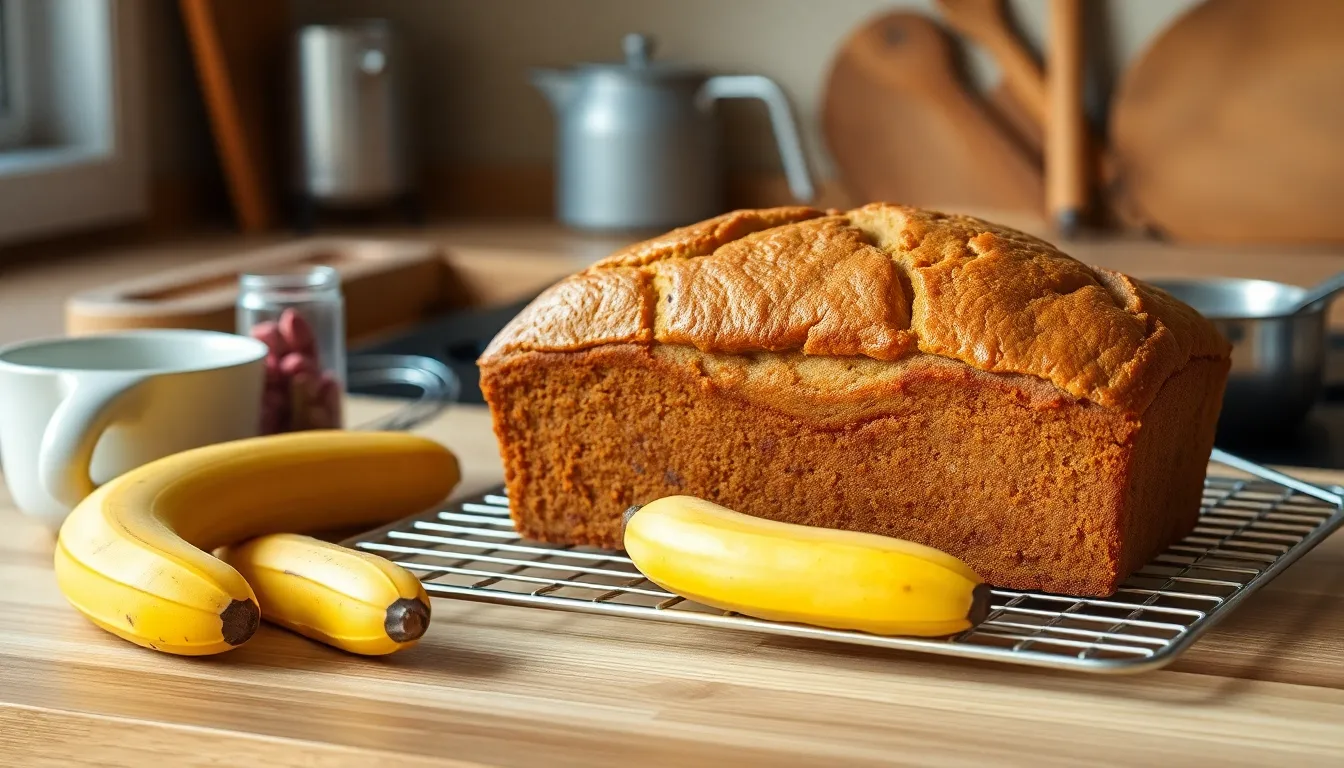Banana bread is a beloved classic that brings warmth and comfort to any kitchen. Its rich aroma and delightful taste make it a favorite among bakers and dessert lovers alike. However, perfecting this delicious treat hinges on one critical factor: cooking time.
Understanding how long to cook banana bread can mean the difference between a moist, flavorful loaf and a dry, overcooked disappointment. With various recipes and oven types, determining the ideal baking duration can be tricky. This guide will help bakers of all skill levels master the timing, ensuring every slice is a delightful experience.
Table of Contents
ToggleUnderstanding Banana Bread
Banana bread offers a delicious, comforting option for dessert, with its moist texture and rich flavor playing a significant role in its popularity. Knowing how long to cook banana bread contributes to a successful baking experience.
Importance of Cooking Time
Cooking time directly affects the banana bread’s texture and taste. Underbaking results in a raw center, while overbaking leads to dryness. Most recipes recommend baking at 350°F for 50 to 70 minutes, depending on the recipe and pan size. Monitoring the bread during baking ensures that it cooks through without losing moisture.
Common Ingredients
Banana bread typically includes simple ingredients that enhance flavor and texture. Key ingredients include:
- Ripe bananas: They add natural sweetness and moisture.
- Flour: All-purpose flour serves as the base, providing structure.
- Sugar: Granulated or brown sugar contributes additional sweetness and helps with browning.
- Eggs: They bind the ingredients, adding moisture and richness.
- Baking soda: A leavening agent that helps the bread rise.
- Salt: Enhances flavor and balances sweetness.
- Fat: Options like butter, oil, or yogurt add richness and moisture.
Understanding these components helps bakers create variations while maintaining the essence of banana bread.
Factors Affecting Cooking Time

Cooking time for banana bread varies due to several key factors. Understanding these elements helps ensure the best baking results.
Oven Temperature
Oven temperature plays a significant role in determining cooking time. Most recipes advocate for a temperature of 350°F, but variations can occur. Higher temperatures, such as 375°F, may reduce cooking time but risk burning the top before the center cooks thoroughly. Conversely, lower temperatures may prolong cooking time, resulting in a dense loaf. It’s essential to use an oven thermometer for accurate temperature readings to maintain consistency.
Bread Size and Shape
Bread size and shape significantly influence how long banana bread takes to cook. Standard loaf pans typically hold 9×5 inches, taking 50 to 70 minutes to bake. Mini loaves or muffins cook faster, often within 30 to 45 minutes, while larger or deeper pans may require extended time, sometimes up to 90 minutes. Choosing the right pan size ensures even heat distribution, affecting the final texture and doneness. Using the toothpick test remains a reliable method; a clean toothpick indicates readiness, while moist batter signals additional baking time.
Recommended Cooking Times
Cooking time significantly influences the final quality of banana bread. Adjustments depend on the loaf’s size and shape.
Standard Cooking Time
Standard banana bread typically bakes for 50 to 70 minutes at 350°F. Most recipes follow this range, with a few factors influencing the exact timing. For example, a darker pan may retain heat more, cooking faster, while a lighter pan may extend baking time. To determine doneness, bakers can use the toothpick test; inserting a toothpick into the center should yield clean results for perfect banana bread.
Mini Loaves and Muffins
Mini loaves and muffins cook faster than standard loaves, generally requiring 20 to 30 minutes. The reduced volume allows for quicker heat penetration, ensuring even cooking. It’s vital to monitor these smaller versions closely as they can overbake quickly. Regularly checking for doneness with the toothpick test ensures a moist, flavorful outcome.
Tips for Perfect Banana Bread
Achieving the ideal banana bread requires careful attention to detail. Utilizing effective techniques ensures a moist and flavorful loaf every time.
Testing for Doneness
Testing for doneness prevents underbaking or overbaking. Insert a toothpick into the center of the loaf; if it comes out clean or with a few moist crumbs, the bread is done. When baking mini loaves or muffins, check for doneness a few minutes earlier, typically around 20 to 25 minutes. Relying on visual cues, such as a golden-brown top and slight cracks, also indicates that the bread is ready to come out of the oven.
Adjusting for Altitude
Adjusting for altitude impacts cooking times and ingredient ratios. At higher elevations, reduce the baking temperature by 25°F to prevent excess rising and potential collapse. Increase the flour amount by 1 to 2 tablespoons to counteract lower air pressure. Bakers may also need to extend baking times slightly, monitoring with the toothpick test to ensure optimal results.
Mastering the cooking time for banana bread is key to achieving that perfect balance of moisture and flavor. By understanding the factors that influence baking duration and consistently testing for doneness, anyone can create a delicious loaf. Whether using standard loaf pans or mini versions, paying attention to the details ensures a delightful outcome every time. With the right techniques and a bit of practice, banana bread can transform from a simple recipe into a cherished favorite that delights both bakers and those lucky enough to enjoy a slice.


